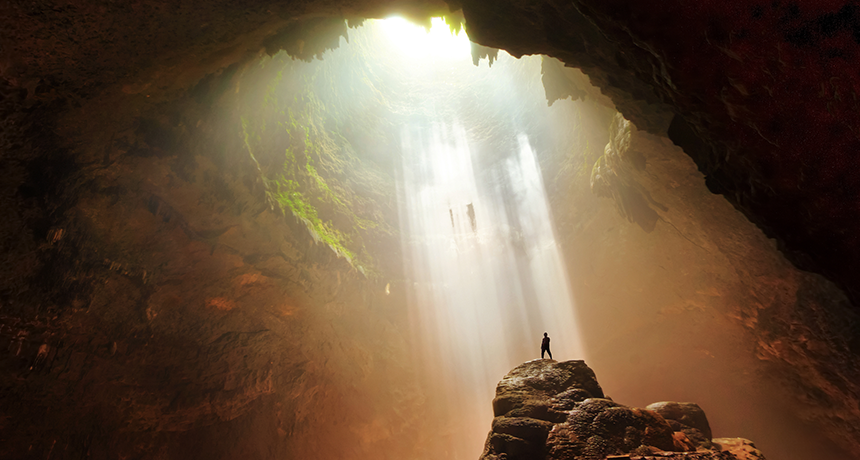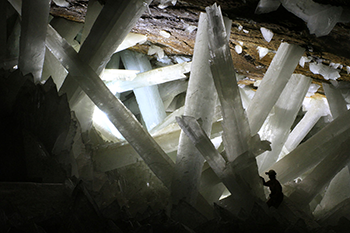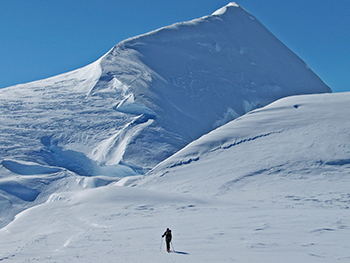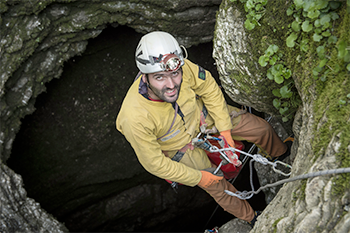Cool Jobs: Bringing caves’ dark secrets to light
These scientists study caves to learn about geology, climate and life at extremes — possibly even in space

A hidden world of caves lies underground, providing scientists with plenty of opportunities for exploration.
BudiNarendra/iStockphoto
The largest crystals on Earth can be found in a cave in Mexico, buried 300 meters (about 1,000 feet) below ground. The biggest of these giants is about as long and wide as a school bus. These crystals crisscross within the cavern. They look like translucent white trees that have fallen in an alien forest. Smaller ones cluster like mineral bushes on the walls and floor.

This is the Cave of Crystals, and it might be one of the most beautiful spots on Earth. It’s not the most comfortable, though. Temperatures here soar to 58° Celsius (136° Fahrenheit). Humidity hovers around 90 percent. People who enter the cave risk heatstroke. They must wear protective suits just to avoid suffocating. Thieves have died trying to steal slivers of the crystals.
The dazzling cave might seem like the last place on Earth to look for life. But it doesn’t seem that way to Penelope Boston. She’s a speleologist (SPEE-lee-OL-uh-gizt) — a scientist who studies caves. And her specialty is life existing in extreme environments.
Scientists have found organisms in plenty of hostile places — some of the hottest, coldest, darkest, deepest and most remote sites on Earth. To find such organisms, however, scientists must travel far and venture into unfriendly places. Including caves.
Some caves have been carved by underground streams. Others have formed during earthquakes or from volcanic activity. Now these sites provide windows to the inner workings of our planet. Protected from the surface, they change slowly — if at all. And this preserves a record of the past and represents one of Earth’s last unexplored frontiers. So to speleologists, caves are natural laboratories, full of possibilities.
A tough place to call home
Boston conducts research below ground. But she started by looking in the opposite direction: to outer space. She’s always wanted to know if life exists on other planets. And she’s always wanted to go to Mars. In graduate school, she helped found The Mars Society. This organization is dedicated to getting people to the Red Planet — and settling there. She is also a past president of the Association of Mars Explorers, a group of scientists and others who are passionate about exploring “the frontiers of Mars.” That includes thinking about where to look for microscopic life on the planet. (If scientists do find microbes, these germs would be the first known Martians!)
The surface of Mars is cold, dry and bombarded by radiation from the sun. It wouldn’t be a pleasant place to live. Boston thinks a better spot to find life would be beneath the Martian surface. Images from orbiting spacecraft have revealed holes in planet’s surface. Scientists suspect these could be natural skylights, leading to underground caverns. Those images from space also show curving troughs on the planet’s surface. These look like collapsed lava tubes, which are underground channels formed by flowing lava.
Traveling to Mars to search for life in these places would be tough. But Earth also has lava tubes and caves. And they are a lot closer than Mars. So scientists like Boston study extremophiles — organisms that live in Earth’s most hostile places — to get an idea of what Martians might resemble, if they exist.
Boston has spent decades looking for microscopic organisms in extreme places. “Over the years, we’ve developed a good eye for [finding] this stuff,” she says. That’s why she went to that hot, humid and spectacular cave in Mexico. She wondered whether anything could be living inside those crystals.
Story continues below video.
Perimeter Institute for Theoretical Physics
All crystals, big or small, develop defects as they grow. These defects are small pockets. Some defects in the Cave of Crystals aren’t empty, though. They contain fluid. Those crystal defects become “little time capsules,” Boston says. She thought their liquids might hold fossils of long-dead bacteria.
To find out, she used a tiny drill to reach the pockets and extract the fluid. When she looked at this liquid under a microscope, she did find fossils. She also found microbes that posed something of a mystery. You see, she couldn’t be sure they were actually dead.
As she toiled in the hot cave, Boston knew she might never return. The cave is owned by a mining company, and, she notes, “The mining company was tired of us being around.” She placed the microbes into a heated dish containing microbe food. Then she rushed them back to her lab at the New Mexico Institute of Mining and Technology in Socorro. There she ran a cave-studies program.
To her surprise, the microbes began to grow in the lab. That meant they were alive!
Nine years later, bacteria from 45 of her original 60 samples are still alive.
To figure out the age of these microbes, she had to know the age of the crystals. Luckily, other scientists had been working on this.
A crystal grows by accumulating new mineral on its outside. The innermost parts are the oldest. Scientists have figured out how fast crystals grow, so Boston could estimate the age of the microbes based on how deeply they had been buried in a crystal. Her colonies of microbes likely are between 10,000 and 50,000 years old, she reported earlier this year at a science meeting.
These microbes may not be aliens, but they are definitely strange. They stay alive without sunlight. For food, they rely on minerals or fluids in the crystal. And they don’t mind the heat or humidity of the cave.
Boston and her team are still studying the samples. They haven’t published their data yet because they want to be sure they’re correct. Other scientists need to look at these data, too, to check the findings.
Still, Boston is excited. For the past year, she’s directed NASA’s Astrobiology Institute in Moffett Field, Calif. (NASA stands for National Aeronautics and Space Administration.) Astrobiology is the study of how life begins and thrives in the universe. Astrobiologists help plan missions to search for life on other planets, such as Mars. Boston’s research will now help guide those missions.
She doesn’t expect to find the same organisms on other planets. Her research, however, shows that life finds a way in the most unexpected places. And if critters can thrive in the Cave of Crystals, then maybe others are thriving on Mars, or even more distant planets and moons.
Climate clues written in stone

For speleologists, getting to work is often the hardest part of the job. They may have to scale cliffs or waterfalls on ropes. They may end up very wet. And their path may be lit only by lamplight. And that’s once they get inside. Just getting to the entrance can be tricky, too. Gina Moseley knows that firsthand.
She’s a speleologist at the University of Innsbruck in Austria. Moseley studies caves to learn about Earth’s past climate. Climate refers to the weather patterns in a particular area over a long period.
In 2015, Moseley’s research led her to caves in Greenland. This island sits mostly above the Arctic Circle. Because it’s so far north, much of Greenland is covered by ice. The island and its ice are sensitive to changes in temperatures. Scientists study Greenland to better understand how Earth’s climate is currently changing.
No one had ever visited the caves that Moseley’s team were headed to before. And for good reason: They’re hard to reach.
The researchers had to hire a small airplane to fly them up Greenland’s East Coast. The plane dropped them off on the edge of a lake. Then they inflated a boat to cross the frigid lake. Once on the other side, they hiked three days to reach the cave. After collecting samples from inside it, they made the long journey back to bring those samples home.
Stalagmites


Some samples came from flowstones. These are mineral sheets formed by water dripping from the ceiling. That water is special, Moseley says. It has traveled from the surface and through the soil and rock above the cave. Before that, it fell from the sky as rain. And before that it was in the ocean. In other words, caves are plugged into the water cycle.
Over time, elements and minerals accumulate in the water like souvenirs from its travels. “That water contains a chemical signature of the ocean and the atmosphere and the soil,” Moseley notes. Those chemical souvenirs include a mineral called calcite (KAL-syte). Over tens or hundreds of thousands of years, calcite piles up into stalagmites and flowstones. Stalagmites are rock formations that rise from the floor of a cave like giant candlesticks. These mineral towers trap information about the past climate.
“When you take one and cut it open, you can see the different layers in there — a lot like tree-ring studies,” says Moseley. Scientists can read the layers like a history book of the region’s climate. During warmer eras, thicker calcite layers grow. During cooler eras, thinner layers form. By measuring carbon, an element found in all living things, researchers can tell if plants had been growing during a particular time period.
Moseley says her team’s research helps show what’s happened to Greenland in the past. Combined with other climate research, her studies add to a bigger picture of how that part of the planet has changed.
Scientists already have studied deep ice samples from Greenland dating back 130,000 years. That means they have a record of warming and cooling periods going all the way back to the beginning of the last Ice Age. But Moseley says she and her team will use cave samples to look back even farther in time.
“Caves are another important cog in a much bigger system,” she says.
Islands of time
Francesco Sauro, too, has studied caves the world over. He’s a speleologist at the University of Bologna in Italy. In recent years, he’s been traveling to caves in northern Venezuela. These South American caves are in mountains called tepuis (TEH-pwee), which rise from the jungle below like tabletops. They may look a little familiar — they inspired Paradise Falls in the movie Up.
Nothing is easy for explorers of the tepuis. The entrances to many caves look like cracks on the side of a cliff. To get there, cavers must first hire a helicopter to carry them to the top of the cliff. But the tepuis are often blanketed in clouds. Fast winds can whip around them. On many days, helicopters can’t fly safely. So Sauro and his team may wait weeks for the conditions to become just right.
Once they reach the top, things get even trickier. The cavers must climb or rappel down to the cave’s entrance, carrying all their equipment in tow. After going to that much trouble, Sauro says, they want to stay. So in 2016, he and his team spent 40 days exploring one cave in the tepuis.
Story continues below video.
TED
Many caves form in limestone, a type of rock that easily dissolves in water. But caves in the tepuis form from quartzite sandstone. This material also dissolves in water, but much more slowly than limestone does. That means the tepui caves are much older than ones in limestone formations. In fact, caves within the tepuis might be the oldest on Earth.
Like Boston, Sauro is interested in learning how rocks and life intersect. He studies the microbes that live inside these caves. He also studies the tepuis to better understand the processes that shape Earth. And he uses lasers to map the inner passages of the caves that he explores.

A tepuis cave is unusual, “different from any other,” Sauro says. Quartzite is pink. That colors the caves’ passages pink, too. Water inside them run red. And the stalagmites and stalactites (which form on cave ceilings) have strange shapes. Some look like marshmallows stuck to the cave’s roof. Others look like fragile bones.
Many of those formations likely host microbes that scientists have not yet identified. Some formations might even owe their creation to microbes, Sauro says.
He has become savvy about finding caves. He knows where to look for clues. To find a cave in the tepuis, he studies satellite maps and looks for sinkholes. He says mountains are a good place to look. If a mountain has no streams or rivers, that means all of its water is going underground. “That is an indication the mass contains some underground network,” he says. In other words: caves.
One of the most interesting things about cave exploration, Sauro says, is that there’s no end in sight. “Not all caves have access to the surface,” he says. That means it’s likely that most of the caves in the world still remain undisturbed. They lie hidden, their secrets awaiting discovery.
This is one in a series on careers in science, technology, engineering and mathematics made possible with generous support from Arconic Foundation.







